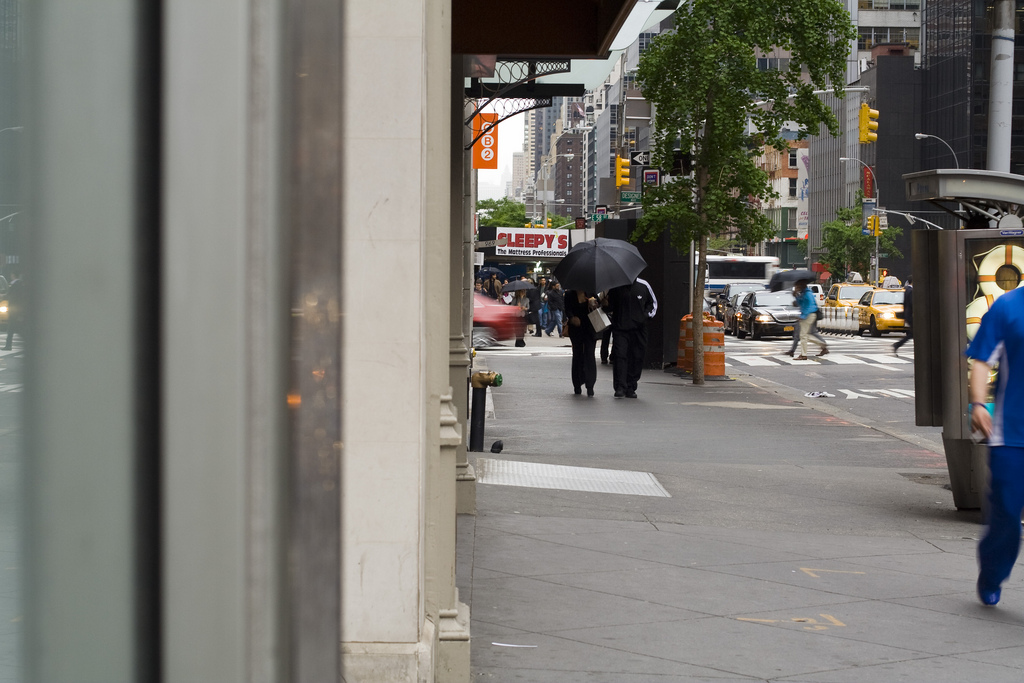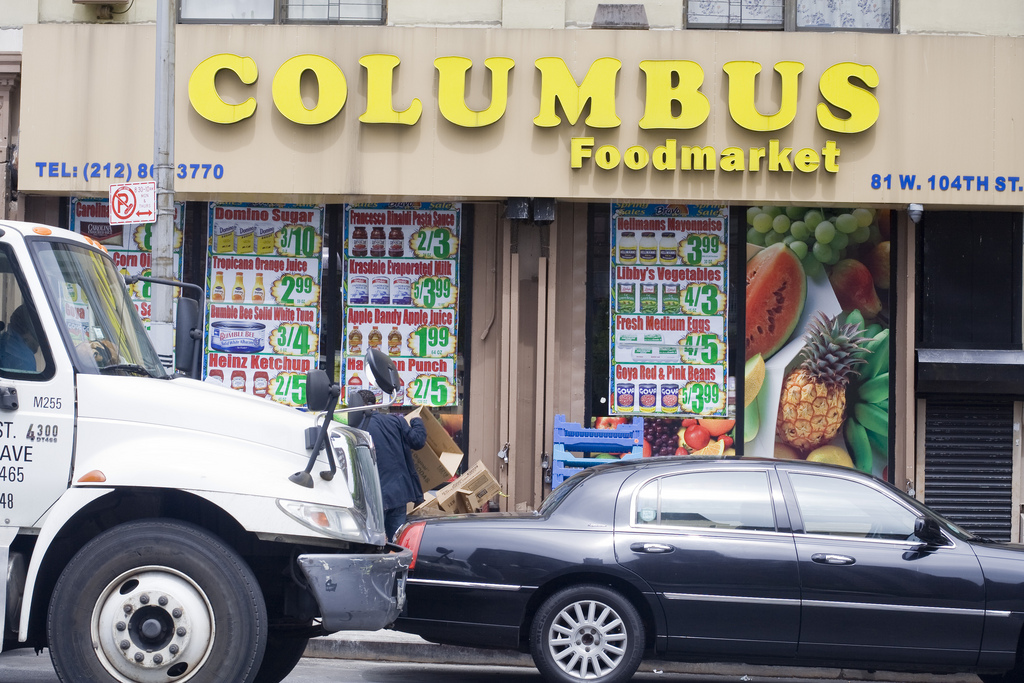
Midtown in the rain, New York City. May 7, 2012
365 Part Deux
Author: MASadmin
It is official: I am too old.
 About six weeks ago, my advisor at seminary approached me to see if she could submit my name to someone at the National Council of Churches who was trying to put together a team of young adults to work on eccumenical issues. My advisor thought I’d be right for the part. However, I had to inform her that I was about to turn 30 and that I might no longer fit into the “young adult” range even if the NCC puts anyone under 40 in the “work with young people” boat. However, I kept my hopes up because I’d love to start working with bigger organizations and get my name out there. Alas, I was told yesterday that they were looking for folks in their mid-twenties. Now, I will just take it as a complement that my advisor thought I was in my mid-twenties but it might be time to face it: I’m never going to be young again. NOOOOOOOOOOOOOOOOOOOOOOOOOOOOOOOOO. I don’t believe it. They can take my pop music, my Chucks, my punk rock, my tshirts, and my skinny jeans from my COLD DEAD HANDS. TAKE THAT WORLD! YEE-HAW!
About six weeks ago, my advisor at seminary approached me to see if she could submit my name to someone at the National Council of Churches who was trying to put together a team of young adults to work on eccumenical issues. My advisor thought I’d be right for the part. However, I had to inform her that I was about to turn 30 and that I might no longer fit into the “young adult” range even if the NCC puts anyone under 40 in the “work with young people” boat. However, I kept my hopes up because I’d love to start working with bigger organizations and get my name out there. Alas, I was told yesterday that they were looking for folks in their mid-twenties. Now, I will just take it as a complement that my advisor thought I was in my mid-twenties but it might be time to face it: I’m never going to be young again. NOOOOOOOOOOOOOOOOOOOOOOOOOOOOOOOOO. I don’t believe it. They can take my pop music, my Chucks, my punk rock, my tshirts, and my skinny jeans from my COLD DEAD HANDS. TAKE THAT WORLD! YEE-HAW!
Actually, I’m fine with it. It was just a lost opportunity that I think would have been a lot of fun to be apart of. And it is a first, actually. It might possibly be the first time I’ve been rejected from a church activity because of my age. For a mainline denomination that is just getting grayer, that doesn’t happen to me too often.
Every Day I’m Pastorin’
 You can never have too many animated gifs in your life. Sadly, only one day of work so far but I’m enjoying it.
You can never have too many animated gifs in your life. Sadly, only one day of work so far but I’m enjoying it.
After two pages, “When the theology in the guest preacher’s sermon is horrible” is my new favorite. “Trying to blend in at clergy meetings” and “When I have on vestments” speak the truth.
Career Disapproval
Over on Carolyn Hax’s Live Chat from last Friday, this question was posted:
Dear Carolyn, I am a female and am on the path to ordained ministry in a mainline Protestant denomination. I am secure in my call to ministry and to becoming a pastor. But I was recently at an event where I met an older gentleman who is from a more traditional and conservative branch of Christianity. Throughout our conversation, he said 3-4 times at least (always trying to pass it off as a joke) that I shouldn’t be a pastor because I am a woman, that I should rethink my career… I can respect his beliefs even though I think he is fundamentally wrong. But how can I extricate myself politely from this situation? I know that I will encounter this attitude again, and I want to be better prepared to handle it.
Carolyn suggests saying “Obviously I disagree. Shall we talk/joke about something else?” while two others throw in with “You are absolutely correct, but I wanted to be certain of my calling before scheduling the sex change surgery” and “My call to ministry is between God and me, and my church has recognized and encouraged it.” I’m not sure exactly what to add to this really. What I think the questioner is asking for is a firm statement to show that she’s serious about her call towards ministry and her church supports her. I don’t know if there is such a statement, really, except for the fact that more than half of the students attending our seminaries are women and that (hopefully) by the time I retire, the amount of women clergy in the ELCA will match the percentage of women in the US (or at least be close). And if we could get a nice number of bishops in there too, I’d appreciate it. I don’t think, for the time being, that this question will go away any time soon. Even with the rise of some women leadership among the younger set in the “evangelicals,” I doubt that the total number of Americans attending churches where female leadership is the norm will happen anytime soon. So, since the ELCA is a minority in this regular, I think the ELCA should approach this issue with guns ablazing. I’d like to see more women considered for positions of leadership within Synods – say, at the dean level. I’d like to see them included in the planning process. And, for us here in Metro-New York, I’d also like to see lay women to have leadership roles and positions in the new Strategic Planning committees that are being developed. And by lay women, I don’t mean deacons. To keep advancing to make women’s leadership a normal thing, supporting well qualified women who are within the church but not with traditional access to leadership areas, should be pushed. And it wouldn’t be hard – I think. Just based on numbers, the Metro-New York Synod already has quite a bit of women leaders that could be harnessed to find more. And they should. Or else we run the risk of spending time on a Strategic Plan that’s just filled with group think and everything will remain the same.
365.259 Waiting for a Subway

168 Street Station (1 Train), New York City. May 6, 2012
365 Part Deux
365.258 Twinkie snoozes

My Apartment in Washington Heights, New York City. May 5, 2012
365 Part Deux
Living the Single Life
 Scott McKnight asked if churches are adjusting to the rise of the number of single people in our society? According to the most recent census data, only 48% of households are husband-wife households. There appears to be a demographic shift in how households are defined in the United States with some places, such as Manhattan and San Francisco having over 40% of its population located in one-person households. The world is changing! And how are there people in Manhattan who can afford to live alone? That’s the burning answer that I want to know.
Scott McKnight asked if churches are adjusting to the rise of the number of single people in our society? According to the most recent census data, only 48% of households are husband-wife households. There appears to be a demographic shift in how households are defined in the United States with some places, such as Manhattan and San Francisco having over 40% of its population located in one-person households. The world is changing! And how are there people in Manhattan who can afford to live alone? That’s the burning answer that I want to know.
Actually, the statistics are fascinating and as the Metropolitan New York Synod begins to analyze where it currently lives, this statistic should be taken into consideration. But who are these single people? I think, in many ways, that’s a tricky question. Although I think it would be possible to assume that these people are mostly young individuals – I think that the more likely answer is that these people are middle aged and over. As the population increases, the divorce rate stays high, and widows keep being created, many single households are gray. Now, if that is true, then it is possible that churches like the ELCA (which are graying anyways) are naturally evolving themselves to reach out to that demographic. But maybe not. In fact, the bigger issue at stake maybe that the church will need to change on how it assume community is created and sustained. The assumed default social networks for individuals, marriage and roommates, no longer exist like they used to. We’re probably living in a world where the default opportunities for connections and networks no longer grip people like they use to. And as part of the transient generation/class in Manhattan, as I discover that I am the one who stayed while everyone seems to leave, I’m realizing that social networks are not as easy to form as they use to. And if that is true, then the church – an organization that is, above all, defined by relationships – much acknowledge this and change accordingly.
This is a fascinating thing to think about on Trinity Sunday when pastors across the country struggle to share what the Trinity means to parishioners. I have yet to preach on Trinity Sunday and I’m sure I’ll struggle with it once I do, but the image of the relationship between Father-Son-Holy Spirit as a cornerstone of our faith seems to align nicely with our recent demographic data. The assumptions about where relationships are created no longer applies. Churches, in many ways, have to work harder to be places where relationships between people, as well as between individuals and Christ, can be harnessed and focused. I think, in many ways, that is part of the underlying component behind what it means to be “welcoming.” Welcoming doesn’t mean smiling at newcomers who enter the door but, rather, being willing to be in relationship with these new people. It means being incarnational with our neighbors. And that is a wonderful butt-kicking thing for me to hear because as I sit in the pews during these summer months, when I’m on my summer “break,” I find myself not wanting to engage with people who show up to worship at my church for the first time. I want to worship as a participant and to let the service, that I adore, wash over me. But that’s a trap in many ways. The reality is that it is through forming relationships that I live out my baptismal calling. Being washed over is fine and dandy but it is only part of the story. There is a world where connections don’t exist like they use to and, as a church, we’re being called to be the body of Christ in the world. We cannot assume that people are able to form their own networks or assume that traditional social networks, such as marriage, are the primary norm through how the church should engage with people. This means that the church can’t be a meat market to create couples, thus allowing the church off the hook when it comes to working hard to maintain social networks. The church needs to engage the singles, the married, the young, the old, the just-graduated, the newly-widowed, in an engaged and loving commitment. We need to invite them into our own Trinity and walk with them for as long as they are on this earth.
365.257 Columbus Box Digging

Upper West Side, New York City. May 4, 2012
365 Part Deux
365.256 In front of buildings GTS no longer owns.

General Theological Seminary, New York City. May 3, 2012
365 Part Deux







